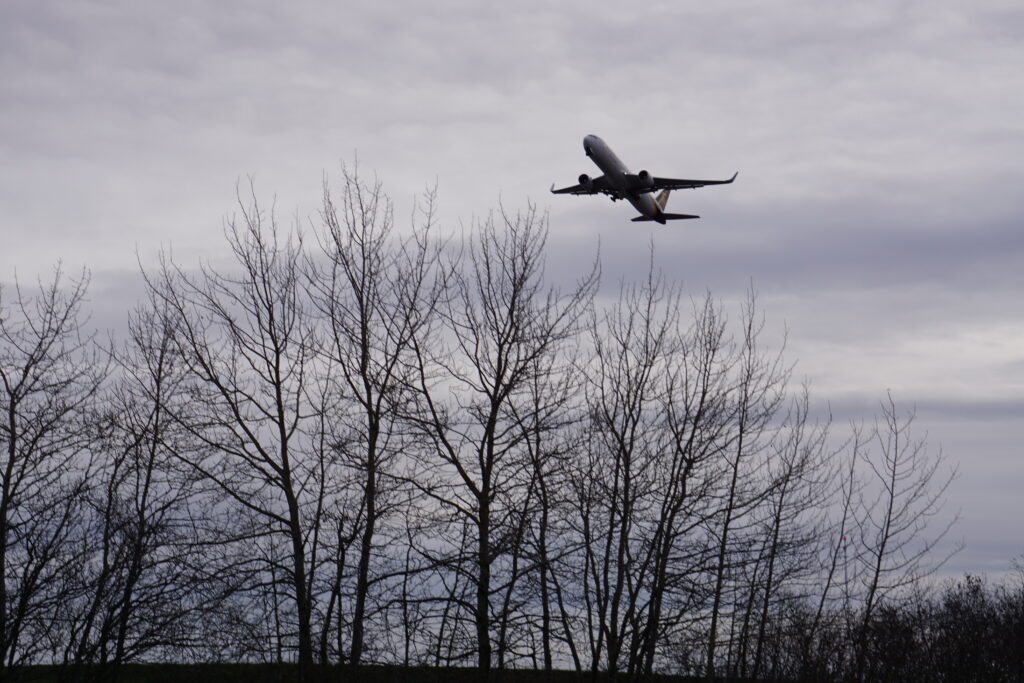A UPS cargo plane takes off from the Ted Stevens Anchorage International Airport on Thursday. The plane is seen from Point Woronzof along the Tony Knowles Coastal Trail. Five new international cargo carriers have started operating at the Anchorage airport, and continued growth is expected in cargo volume handled there. (Photo by Yereth Rosen/Alaska Beacon)
Five additional air cargo companies have started operating this year at the Ted Stevens Anchorage International Airport, boosting an important sector of the economy in the state’s largest city, state officials said on Thursday.
The five new operators, all of them international, boost the number of cargo carriers to 39, according to the Department of Transportation and Public Facilities. Thirty-one, including the new arrivals, are international carriers, while eight are regional carriers, according to the department.
The companies newly operating in Anchorage are Awesome Cargo, based in Mexico; Central Airlines of China; ASL Air Cargo, a Belgian carrier; Aerologic Air Cargo, a German company; and CMA CGM Air Cargo, which is based in France.
Ryan Anderson, commissioner of the Alaska Department of Transportation and Public Facilities, said the new arrivals show how the cargo business is growing in Anchorage, with the state’s help.
“We’re really focused on expanding our capacity for cargo,” he said at a news conference held at the Anchorage airport’s fire station. To that end, the department has created an interdisciplinary cargo team that is planning the changes needed to accommodate increased cargo traffic, he said.
Those plans include physical expansion of taxiways as well as modernization of energy use, such as the integration of solar energy and other renewable sources, Anderson said.
The Anchorage airport, with its strategic position between continents, has long been one of the world’s busiest for cargo traffic. For a while in 2020, at the early part of the COVID-19 pandemic, it was the top cargo airport, though it has generally been in the second spot nationally – after Memphis, the headquarters of FedEx – and in the top five internationally.
As of 2023, Anchorage ranked fourth in the world in the amount of cargo shipped, according to Airports Council International (ACI) World, an aviation industry organization.
While cargo volume slipped a bit between 2022 and 2023, it has since increased, according to state officials. Cargo volume passing through the Anchorage airport increased 4.9% from fiscal 2023 to fiscal 2024, according to the department. Alaska’s fiscal year runs from July 1 to June 30, so fiscal 2024 ended in the middle of summer.
Bins of old PFAS-containing firefighting foams are seen on Oct. 24, 2024, at the Ted Stevens Anchorage International Airport fire department headquarters. The PFAS foams are due to be removed and sent to a treatment facility. The airport, like all other state-operated airports, is to switch to non-PFAS firefighting foams by the start of 2025, under a new state law. (Photo by Yereth Rosen/Alaska Beacon)
Volume through the airport is expected to grow by another 2% this fiscal year, reaching what is anticipated to be a record 149.5 million pounds, according to the department.
Also underway at the Anchorage airport, as with all other state-operated airports, is a transition to firefighting foams that are free of per- and polyfluoroalkyl substances, or PFAS chemicals. Linked to numerous health problems such as cancer and reproductive problems, PFAS compounds are commonly called “forever chemicals” because they are extremely persistent in the environment and in bodies of people and animals. In Alaska, as in most of the nation, the biggest source of PFAS contamination in the environment is from firefighting foams, largely those used at airports and at military sites.
A newly enacted law in Alaska requires airport fire departments to switch to non-PFAS foams by Jan. 1.
At the Anchorage airport, officials said they are striving to meet that deadline.
“It’s something we’ve been diligently working on since the legislation passed,” said Aaron Danielson, the police and fire chief at the Ted Stevens Anchorage International Airport.
Companies that sell non-PFAS foams have already been identified, thanks in part to the military branches that have already started switching out their foams, he said. There are now four vendors offering to sell safer foams to the state, so no supply problems are expected, he said.
The challenge will be getting all the firefighting trucks and equipment properly cleaned so that the non-PFAS foams can be used, Danielson said.
Qualified cleaners to handle PFAS-contaminated equipment are few, and they will be needed at all state-operated airports, not just Anchorage, he said. “It’ll be a process for all of us, and it’ll get phased through, to get the cleaners coming through to one department, to another department and continue moving on,” he said.
Anderson said the department has the money for the switchover in this year’s budget and that the deadline is in sight.
“We expect that this winter we will have this equipment clean, and we’ll be fully functional with the new foams,” he said. “It’s a high priority for us.”
YOU MAKE OUR WORK POSSIBLE.

